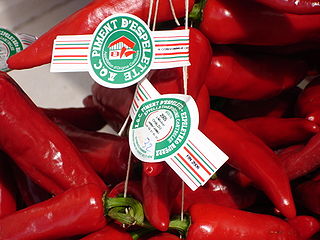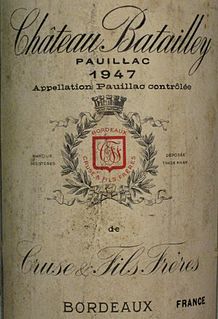Coordinates: 44°53′41″N0°08′42″W / 44.89478°N 0.14508°W

A geographic coordinate system is a coordinate system that enables every location on Earth to be specified by a set of numbers, letters or symbols. The coordinates are often chosen such that one of the numbers represents a vertical position and two or three of the numbers represent a horizontal position; alternatively, a geographic position may be expressed in a combined three-dimensional Cartesian vector. A common choice of coordinates is latitude, longitude and elevation. To specify a location on a plane requires a map projection.
Contents
Château Trotte Vieille, alternately Château Trottevieille, is a Bordeaux wine producer from the appellation Saint-Émilion, ranked Premier grand cru classé B in the Classification of Saint-Émilion wine. The estate is located in the Right Bank of France’s Bordeaux wine region in the commune of Saint-Émilion, in the department Gironde.

A Bordeaux wine is any wine produced in the Bordeaux region of southwest France. Bordeaux is centered on the city of Bordeaux, on the Garonne River. To the north of the city the Dordogne River joins the Garonne forming the broad estuary called the Gironde and covering the whole area of the Gironde department,with a total vineyard area of over 120,000 hectares, making it the largest wine growing area in France. Average vintages produce over 700 million bottles of Bordeaux wine, ranging from large quantities of everyday table wine, to some of the most expensive and prestigious wines in the world. The vast majority of wine produced in Bordeaux is red, with sweet white wines, dry whites, and rosé and sparkling wines collectively making up the remainder. Bordeaux wine is made by more than 8,500 producers or châteaux. There are 54 appellations of Bordeaux wine.

The appellation d'origine contrôlée is the French certification granted to certain French geographical indications for wines, cheeses, butters, and other agricultural products, all under the auspices of the government bureau Institut national des appellations d'origine, now called Institut national de l'origine et de la qualité (INAO). It is based on the concept of terroir.

Saint-Émilion is an appellation d'origine contrôlée (AOC) for wine in the Bordeaux wine region of France, where it is situated in the Libourne subregion on the right bank of the Dordogne. Saint-Émilion is registered as a World Heritage Site by UNESCO, the United Nations Educational, Scientific and Cultural Organization.
The estate also produces the second wine La Vieille Dame de Trotte Vieille.

Second wine or second label is a term commonly associated with Bordeaux wine to refer to a second label wine made from cuvee not selected for use in the Grand vin or first label. In some cases a third wine or even fourth wine is also produced. Depending on the house winemaking style, individual plots of a vineyard may be selected, often those of the youngest vines, and fermented separately, with the best performing barrels being chosen for the house's top wine and the other barrels being bottled under a separate label and sold for a lower price than the Grand vin.



